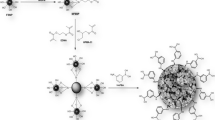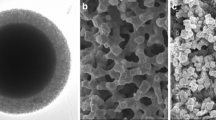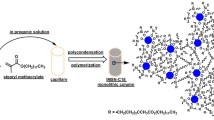Abstract
Various recent wide-pore reversed-phase stationary phases were studied for the analysis of intact monoclonal antibodies (mAbs) of 150 kDa and their fragments possessing sizes between 25 and 50 kDa. Different types of column technology were evaluated, namely, a prototype silica-based inorganic monolith containing mesopores of ∼250 Å and macropores of ∼ 1.1 μm, a column packed with 3.6 μm wide-pore core-shell particles possessing a wide pore size distribution with an average around 200 Å and a column packed with fully porous 1.7 μm particles having pore size of ∼300 Å. The performance of these wide-pore materials was compared with that of a poly(styrene–divinyl benzene) organic monolithic column, with a macropore size of approximately 1 μm but without mesopores (stagnant pores). A systematic investigation was carried out using model IgG1 and IgG2 mAbs, namely rituximab, panitumumab, and bevacizumab. Firstly, the recoveries of intact and reduced mAbs were compared on the two monolithic phases, and it appeared that adsorption was less pronounced on the organic monolith, probably due to the difference in chemistry (C18 versus phenyl) and the absence of mesopores (stagnant zones). Secondly, the kinetic performance was investigated in gradient elution mode for all columns. For this purpose, peak capacities per meter as well as peak capacities per time unit and per pressure unit (PPT) were calculated at various flow rates, to compare performance of columns with different dimensions. In terms of peak capacity per meter, the core-shell 3.6 μm and fully porous 1.7 μm columns outperformed the two monolithic phases, at a temperature of 60 °C. However, when considering the PPT values, the core-shell 3.6 μm column remained the best phase while the prototype silica-based monoliths became very interesting, mostly due to a very high permeability compared with the organic monolith. Therefore, these core-shell and silica-based monolith provided the fastest achievable separation. Finally, at the maximal working temperature of each column, the core-shell 3.6 μm column was far better than the other one, because it is the only one stable up to 90 °C. Lastly, the loading capacity was also measured on these four different phases. It appeared that the organic monolith was the less interesting and rapidly overloaded, due to the absence of mesopores. On the other hand, the loading capacity of prototype silica-based monolith was indeed reasonable.









Similar content being viewed by others
References
Guiochon G (2007) J Chromatog A 1168:101–168
Cabrera K (2004) J Sep Sci 27:843–852
Hjerten S, Liao JL, Zhang R (1989) J Chromatogr 473:273–275
Svec F, Frechet JMJ (1992) Anal Chem 64:820–822
Minakuchi H, Nakanishi K, Soga N, Ishizuka N, Tanaka N (1996) Anal Chem 68:3498–3501
Eeltink S, Wouters B, Desmet G, Ursem M, Blinco D, Kemp GD, Treumann A (2011) J Chromatog A 1218:5504–5511
Detobel F, Broeckhoven K, Wellens J, Wouters B, Swart R, Ursem M, Desmet G, Eeltink S (2010) J Chromatog A 1217:3085–3090
Hormann K, Müllner T, Bruns S, Höltzel A, Tallarek U (2012) J Chromatog A 1222:46–58
Knox JH (1977) J Chromatogr Sci 15:352–364
Poppe H (1997) J Chromatogr A 778:3–21
Giddings JC (1965) Anal Chem 37:60–63
MacNair JE, Lewis KC, Jorgenson JW (1997) Anal Chem 69:983–989
Jerkovich AD, Mellors JS, Jorgenson JW (2003) LC-GC Europe 16:20–23
Mazzeo JR, Neue UD, Kele M, Plumb RS (2005) Anal Chem 77:460–467
Guillarme D, Nguyen DTT, Rudaz S, Veuthey JL (2006) J Sep Sci 29:1836–1848
Eugster PJ, Guillarme D, Rudaz S, Veuthey JL, Carrupt PA, Wolfender JL (2011) AOAC Int 94:51–70
Novakova L, Vlckova H (2009) Anal Chim Acta 656:8–35
Staub A, Guillarme D, Schappler J, Veuthey JL, Rudaz S (2011) J Pharm Biomed Anal 55:810–822
Fekete S, Berky R, Fekete J, Veuthey JL, Guillarme D (2012) J Chromatogr A 1236:177–188
Krull IS, Rathore A (2011) LCGC North Am 29:838–852
Fekete S, Fekete J, Ganzler K (2009) J Pharm Biomed Anal 49:64–71
Ruta J, Zurlino D, Grivel C, Heinisch S, Veuthey JL, Guillarme D (2012) J Chromatogr A 1228:221–231
Guiochon G, Gritti F (2011) J Chromatogr A 1218:1915–1938
Kirkland JJ (1992) Anal Chem 64:1239–1245
Liekens A, Denayer J, Desmet G (2011) J Chromatogr A 1218:4406–4416
Olah E, Fekete S, Fekete J, Ganzler K (2010) J Chromatogr A 1217:3642–3653
Fanigliulo A, Cabooter D, Bellazzi G, Tramarin D, Allieri B, Rottigni A, Desmet G (2010) J Sep Sci 33:3655–3665
Staub A, Zurlino D, Rudaz S, Veuthey JL, Guillarme D (2011) J Chromatogr A 1218:8903–8914
Fekete S, Rudaz S, Fekete J, Guillarme D (2012) J Pharm Biomed Anal 70:158–168
Fekete S, Rudaz S, Veuthey JL, Guillarme D (2012) J Sep Sci. doi:10.1002/jssc.201200297
Snyder LR (1980) In: Horvath C (ed) Gradient elution in HPLC: advances and perspectives, vol. 1. Academic Press, New York
Snyder LR, Kirkland JJ, Glajch JL (1997) Practical HPLC method development, 2nd edn. John Wiley & Sons Inc., New York
Giddings JC (1967) Anal Chem 39:1027–1028
Horvath C, Lipsky SR (1967) Anal Chem 39:1893–1895
Neue UD (2005) J Chromatogr A 1079:153–161
Wang X, Stoll DR, Schellinger AP, Carr PW (2006) Anal Chem 78:3406–3416
Dolan JW, Snyder LR, Djordjevic NM, Hill DW, Waeghe TJ (1999) J Chromatogr A 857:1–20
Neue UD, Mazzeo JR (2001) J Sep Sci 24:921–929
Neue UD, Carmody JL, Cheng YF, Lu Z, Phoebe CH, Wheat TE (2001) Adv Chromatogr 41:93–136
Neue UD, Cheng YF, Lu Z (2006) In: Kromidas S (ed) HPLC made to measure: a practical handbook for optimization. Wiley-VCH, Weinheim
Schuster SA, Boyes BE, Wagner BM, Kirkland JJ (2012) J Chromatogr A 1228:232–241
Neue UD (2008) J Chromatogr A 1184:107–130
Wang X, Stoll DR, Carr PW, Schoenmakers PJ (2006) J Chromatogr A 1125:177–181
Zhang Y, Wang X, Mukherjee P, Petersson P (2009) J Chromatogr A 1216:4597–4605
Causon TJ, Hilder EF, Shellie RA, Haddad PR (2010) J Chromatogr A 1217:5063–5068
Ruta J, Guillarme D, Rudaz S, Veuthey JL (2010) J Sep Sci 33:2465–2477
Broeckhoven K, Cabooter D, Lynen F, Sandra P, Desmet G (2010) J Chromatogr A 1217:2787–2795
Broeckhoven K, Cabooter D, Eeltink S, Desmet G (2012) J Chromatogr A 1228:20–30
Bristow PA, Knox JH (1977) Chromatographia 10:279–289
Fekete S, Fekete J (2011) Talanta 84:416–423
Wang X, Barber WE, Carr PW (2006) J Chromatogr A 1107:139–151
McCalley DV (2006) Anal Chem 78:2532–2538
Fekete S, Berky R, Fekete J, Veuthey JL, Guillarme D (2012) J Chromatogr A 1252:90–103
Lundell N, Schreitmuller T (1999) Anal Biochem 266:31–47
Williams KR, Stone KL (1995) Methods Mol Biol 40:157–175
Yan B, Valliere-Douglass J, Brady L, Steen S, Han M, Pace D, Elliott S, Yates Z, Balland A, Wang W, Pettit D (2007) J Chromatogr A 1164:153–161
Kleemann G, Beierle J, Nichols A, Dillon T, Pipes G, Bondarenko P (2008) Anal Chem 80:2001–2009
Dillon TM, Bondarenko PV, Rehder DS, Pipes GD, Kleemann GR, Ricci MS (2006) J Chromatogr A 1120:112–120
Yang J, Wang S, Liu J, Raghani A (2007) J Chromatogr A 1156:174–182
Yan B, Eris T, Yates Z, Hong RW, Steen S, Kleemann G, Wang W, Liu JL (2009) J Chromatogr B 877:1613–1620
Acknowledgments
The authors wish to thank Dr. Karin Cabrera (Merck KGaA) for providing the new wide-pore silica-based monolithic research samples (C18, 100 × 4.6 mm, KN2229, VNr. 4463.06).
Author information
Authors and Affiliations
Corresponding author
Rights and permissions
About this article
Cite this article
Fekete, S., Veuthey, JL., Eeltink, S. et al. Comparative study of recent wide-pore materials of different stationary phase morphology, applied for the reversed-phase analysis of recombinant monoclonal antibodies. Anal Bioanal Chem 405, 3137–3151 (2013). https://doi.org/10.1007/s00216-013-6759-7
Received:
Revised:
Accepted:
Published:
Issue Date:
DOI: https://doi.org/10.1007/s00216-013-6759-7




